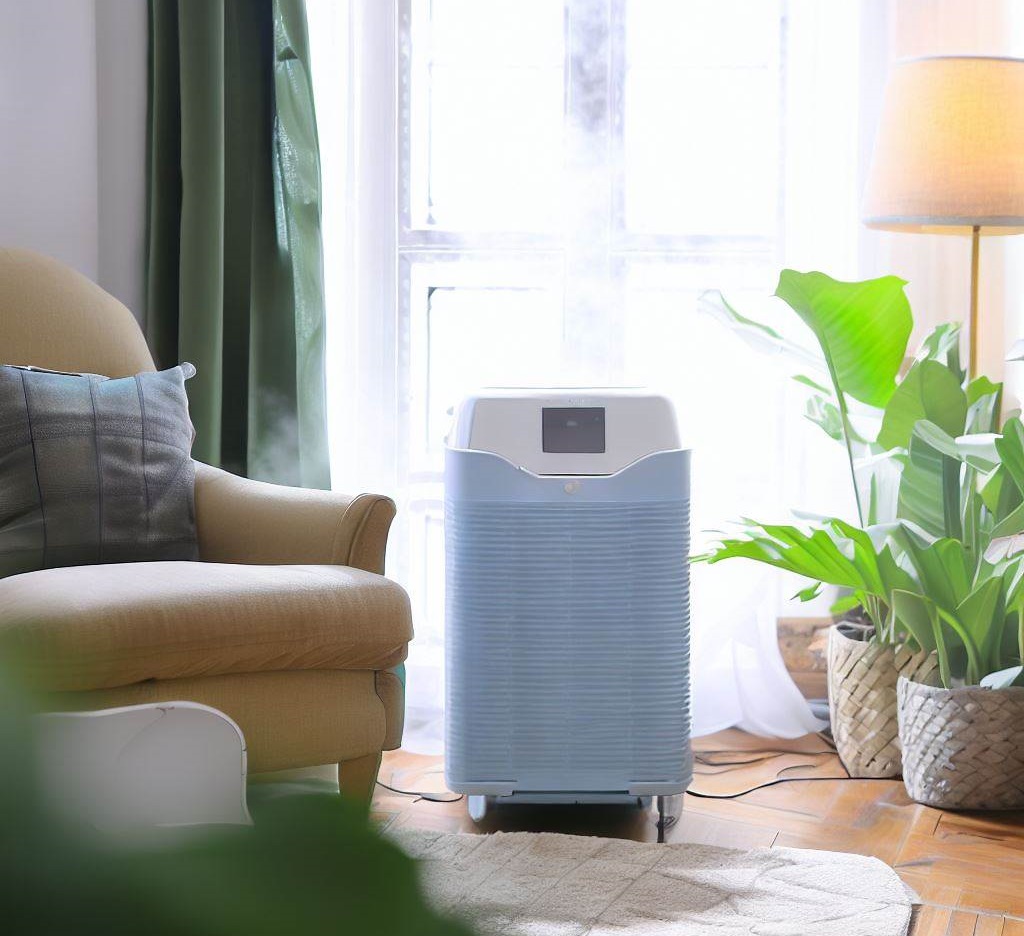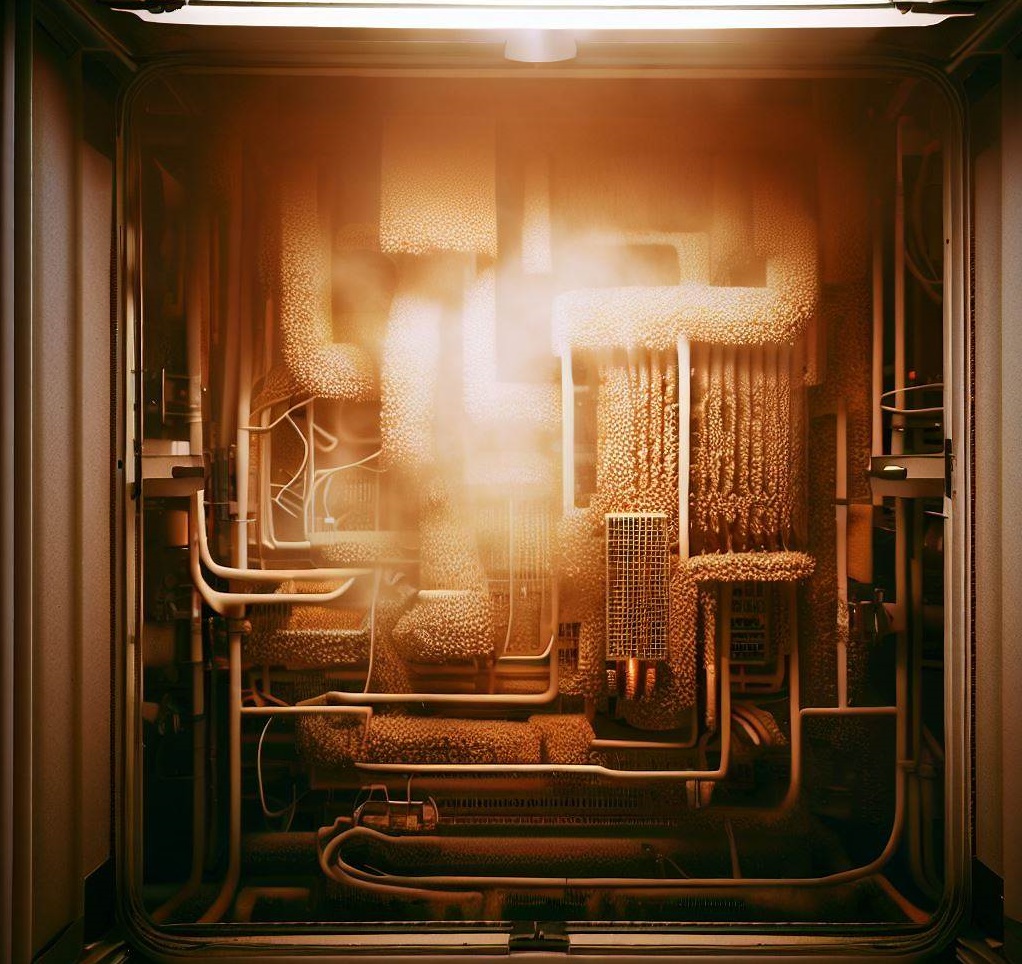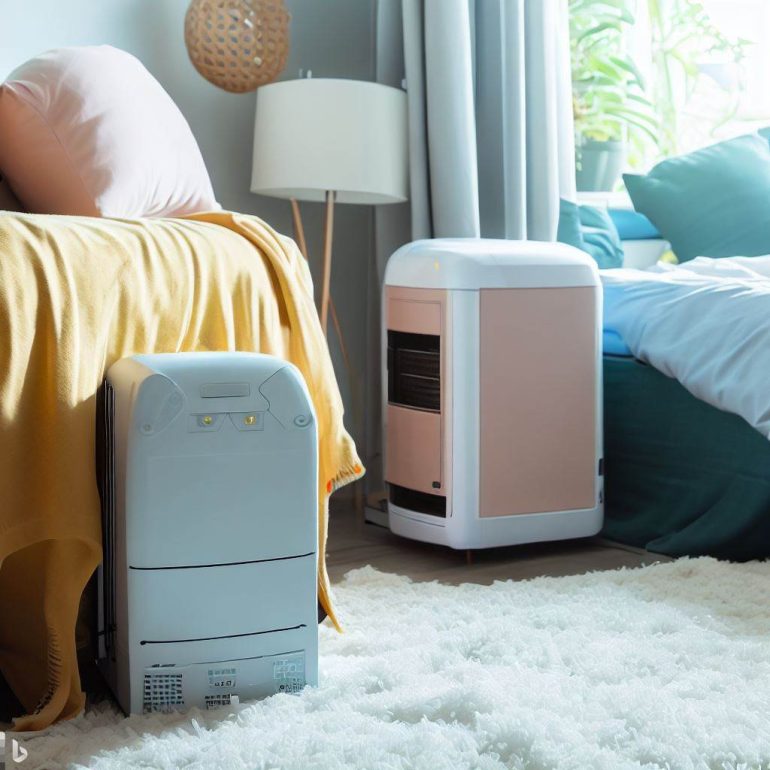Do you suffer from excess humidity in your home or office? You’re not alone. High humidity can cause all sorts of problems, like mould, mildew, and condensation. It can also make the air feel stuffy and uncomfortable, making it hard to relax and breathe easily.
The good news is that you don’t have to put up with these unpleasant conditions; there are two types of dehumidifiers on the market that can help: desiccant or compressor dehumidifiers.
In this article, we’ll explore the differences between these two types of dehumidifiers so that you can decide which one is best for your needs. We’ll discuss the advantages and disadvantages of each type – from operating costs to size and maintenance – so that you can take back control over your environment and create a comfortable, healthy space for yourself and your family.
Finally, we’ll provide some tips for getting the most out of your chosen dehumidifier so that you can be sure it’s running efficiently at all times. So if you’re ready to get rid of humidity issues once and for all, keep reading to learn more about desiccant or compressor dehumidifiers!
Desiccant Vs Compressor Dehumidifier

Homeowner in a humid climate wants to protect their home and possessions from moisture damage. They must decide between two different kinds of dehumidifiers: desiccant and compressor.
Desiccant dehumidifiers use a chemical agent called a desiccant, which absorbs the moisture in the air. In contrast, compressor dehumidifiers use refrigeration to cool the air and condense the moisture.
Desiccant dehumidifiers are more energy efficient than compressor ones because they require less electricity. They also tend to be quieter and have fewer moving parts, so they last longer.
On the other hand, compressor dehumidifiers are better for quickly removing large amounts of moisture from the air, making them ideal for areas with high humidity levels, such as laundry areas and basements.
Each type of dehumidifier has its advantages and disadvantages. But no matter which one you choose, getting one that fits your needs and budget is essential. Now let’s look at why dehumidification is beneficial in the first place.
Benefits Of Dehumidification

Humidity can have a huge negative impact on the air quality of an indoor space. High humidity levels create a breeding ground for allergens, irritants and harmful bacteria. Fortunately, dehumidifiers offer several benefits that help improve air quality and make your home more comfortable.
The primary benefit of dehumidifying an indoor space is improved air quality. By reducing humidity levels, dehumidifiers can reduce the number of dust mites, mould spores and other airborne allergens. This helps reduce inflammation in the respiratory system, leading to better sleep quality and fewer allergy symptoms.
In addition to improving air quality, using a dehumidifier also helps to reduce condensation on surfaces such as walls, windows and furniture. This reduces the risk of mould growth and structural damage caused by dampness. Dehumidifiers also help to reduce musty odours caused by high humidity levels.
Here are three key benefits of using a dehumidifier:
1. Improved air quality
2. Reduced condensation
3. Elimination of musty odours
Using a dehumidifier is one of the best ways to maintain comfortable indoor humidity levels while keeping your home free from allergens and mould growth. Furthermore, it can save you money in costly repairs due to water-related damage or mould remediation.
All these factors make investing in a dehumidifier well worth it for any homeowner who wants to keep their home safe and comfortable year-round. With this in mind, let’s look at the different types of dehumidifiers available today!
Types Of Dehumidifiers

When it comes to controlling moisture levels in an indoor environment, there are two main types of dehumidifiers – desiccants and compressors. Each type has distinct advantages and disadvantages, making it important to understand their differences.
Desiccant dehumidifiers use a desiccant material, such as silica gel or activated alumina, to absorb moisture from the air. This type of dehumidifier is often preferred for homes and other buildings with high humidity levels because it does not rely on refrigeration systems like compressor dehumidifiers.
Desiccant dehumidifiers are also more energy-efficient than compressor models since they don’t require large amounts of electricity. However, they can also be quite noisy and don’t work as quickly as compressor units.
Compressor dehumidifiers use a refrigeration system to cool the air and then condense moisture out of it. This type of unit is usually much faster at removing moisture from an indoor space than a desiccant model, but it consumes more energy in the process.
Compressor dehumidifiers are also larger than most desiccant models, so they may not be suitable for smaller rooms or spaces with limited floor space. With that said, these units are great for large areas where there’s a need for rapid moisture removal without having to worry about excess noise or heat production. Now that we’ve explored the different types of dehumidifiers available let’s take a look at how does a desiccant dehumidifier work?
How Does A Desiccant Dehumidifier Work?

Imagine a desert. It’s hot and dry, and the air is so parched it’s practically empty of moisture. Now imagine that in this desert, there’s a small oasis of cool, damp air. That’s what a desiccant dehumidifier does; it takes damp air, sucks out the moisture, and leaves us with a relaxed, dry atmosphere.
How does it do that? It all comes down to the chemical properties of silica gel – the same stuff you find in those little packets you get when you buy shoes or electronics. This material is highly absorbent and can draw moisture from the air like a sponge.
The desiccant dehumidifier contains two chambers separated by a membrane made up of silica gel beads that act as tiny sponges. As moist air passes through one side of the membrane, the beads soak up the moisture until they reach their maximum capacity. Then they release their load into the other chamber, which is drained away for disposal or reuse.
The process is continuous: as soon as enough water has been collected on one side of the membrane, fresh dry air moves in to take its place while allowing the other side to continue releasing its load. By doing this repeatedly, the dehumidifier works tirelessly to keep our homes free from excess humidity while providing us with all the comfort we need.
Advantages Of The Desiccant System
The desiccant system offers many advantages over a compressor dehumidifier. Firstly, it is much quieter and easier to install in any environment. It also requires less maintenance than the compressor system, making it ideal for those who don’t have much time or resources to devote to upkeep.
Moreover, the desiccant system is more energy efficient than its compressor counterpart. This makes it a great choice for those looking to reduce their electricity bills. Lastly, the desiccant system does not blow air around the room like a compressor system; instead, it absorbs moisture from the air and traps it within itself.
This makes it an ideal solution for people living in areas with high humidity levels who want to maintain a comfortable living environment without constantly running their AC units. As you can see, using a desiccant system over a compressor dehumidifier has many advantages.
In addition to these benefits, other factors make the desiccant system especially attractive. The desiccant systems are highly efficient and do not require expensive filters that need regular replacement, like compressor systems.
This means that they cost significantly less in terms of upfront and ongoing maintenance costs. Furthermore, since they don’t emit noise or vibrations like other dehumidifiers, they can be used in areas where noise pollution is an issue without causing any disruptions or annoyances.
All this adds up to show that when compared to its competitors, the desiccant system has quite a few advantages. Without further ado, though, let’s move on to discussing the disadvantages of this type of dehumidifier.
Disadvantages Of The Desiccant System
The desiccant system is not without its drawbacks. In the same way that a garden needs water, so does this dehumidifier need refilling with water, or will it stop working? It’s a lot like tending to a thirsty pet; if you forget to refill it, your home won’t be as dry as you want. Additionally, a desiccant dehumidifier uses more energy than a compressor one. This means that while it may save on electricity costs in the short term, over the long term, it can be more expensive than its counterpart. It also tends to be noisier and heavier than compressor models, making them less ideal for areas where noise and weight are an issue.
Despite these drawbacks, the desiccant system still has its advantages and may make more sense in certain scenarios. But if you’re looking for something that comes without any of these issues, then understanding how a compressor dehumidifier works might give you what you need.
How Does A Compressor Dehumidifier Work?

Now that you know the disadvantages of the desiccant system, let’s shift gears and discuss how a compressor dehumidifier works. A compressor dehumidifier uses a refrigeration process to remove moisture from the air. This process involves compressing the hot, humid air in an evaporator coil to a much colder temperature, which causes condensation on the coil. The condensed moisture is then removed and collected in a water tank or drain hose.
The advantages of a compressor dehumidifier are:
– It can remove more moisture than a desiccant system.
– It is also more energy efficient than other types of dehumidifiers.
– It can operate at lower temperatures compared to other systems.
– It is quieter than other types of dehumidifiers.
Compressor dehumidifiers are ideal for areas that need consistent humidity control, such as basements and crawl spaces. They are also well suited for large buildings like warehouses or factories with heavy equipment running or production lines operating that generate high humidity levels.
They can be used in both commercial and residential applications, making them extremely versatile for controlling indoor moisture levels. Additionally, they come in various sizes and capacities, so you can find one that fits your specific needs perfectly!
All things considered, it’s clear why many people choose compressor dehumidifiers over other systems when it comes to controlling indoor humidity levels: they’re powerful yet energy efficient; they can operate at low temperatures; they come in different sizes; and they’re relatively silent compared to other models on the market!
With all these benefits, it’s no wonder why compressor dehumidifiers are quickly becoming one of the most popular options available today. Moving on, let’s look at some of the advantages this system offers compared to other types of dehumidification solutions.
Advantages Of The Compressor System
The compressor system offers many advantages over desiccant systems for dehumidification. First, the compressor system is much faster and more efficient than a desiccant system. This type of dehumidifier can remove moisture from the air at rates of up to 20 litres per day and quickly bring an area back to a comfortable humidity level. It also features an automatic shut-off switch that prevents it from running too long and wasting energy.
Another advantage of the compressor system is that it’s relatively quiet compared to other dehumidifiers, making it ideal for bedrooms or living spaces where noise levels are important. Furthermore, its design is compact and lightweight, so it can be easily moved around and won’t take up much space in your home.
Finally, this type of dehumidifier requires little maintenance and comes with several safety features, providing peace of mind that your home environment will remain comfortable year-round.
With these advantages in mind, it’s easy to see why many people prefer the compressor system for their dehumidification needs. Transitioning into the disadvantages of the compressor system reveals another side to this technology.
Disadvantages Of The Compressor System
The disadvantages of the compressor system are vast and far-reaching. Like a ship taking on water, this type of dehumidifier often has significant issues with reliability and maintenance.
Simply put, these systems tend to break down over time due to their complex designs and mechanical components. This can lead to costly repairs, replacement parts, and long periods of downtime for the device.
Furthermore, compressor systems are usually much louder than desiccant systems. In addition to being disruptive in certain environments, this extra noise pollution can also be an annoyance in residential settings.
Furthermore, these models tend to cost more upfront than their desiccant counterparts, making them an expensive choice for those looking for a lower-cost option.
Comparison Between Desiccant And Compressor Systems
The compressor system has many drawbacks. It is loud, inefficient and prone to frequent breakdowns. Now let’s take a closer look at how a desiccant dehumidifier compares.
Desiccant systems are much quieter than compressor models and use less energy too. This makes them an attractive option for those wishing to reduce their energy bill or decrease noise levels in the home.
Additionally, these systems don’t suffer from the same reliability issues that plague compressors and are generally built with more robust materials.
So when it comes to choosing between a compressor and a desiccant system, there are several factors to consider. Cost is one factor, as desiccants tend to be more expensive initially but have lower long-term running costs due to their superior efficiency and reliability compared to compressors.
Noise levels and installation requirements must also be considered when selecting a dehumidifier best suited for your needs.
Factors To Consider When Choosing A Dehumidifier
Choosing the right dehumidifier is like a game of chess: you must consider all your options and select the best one to suit your needs. Whether you opt for a desiccant or compressor dehumidifier, there are several factors to consider.
Firstly, think about the size of the space you want to dehumidify. This will help determine which type of machine would be most effective. Desiccant dehumidifiers tend to be more suited for smaller spaces due to their portability and energy efficiency, while compressor units are usually better for larger areas as they provide higher levels of moisture removal.
Secondly, consider how often you plan to use the machine. Suppose you’re only going to be running it occasionally. In that case, a desiccant model could work well, but if you’re planning on using it on a daily basis then a compressor unit may be better suited for your needs.
Finally, take into account the humidity levels in your area. Desiccant models perform better in lower humidity environments, whereas compressor units can cope with more humid conditions.
With this in mind, it’s important to select a machine capable of managing both extremes of moisture levels within your home or office. Operating cost considerations should also be considered when deciding which dehumidifier type is right for you.
Operating Cost Considerations
Desiccant and compressor dehumidifiers both have different benefits in terms of cost and efficiency. A dehumidifier’s operating costs are important to consider before making a purchase. Here’s a breakdown of the main differences between the two when it comes to operating expenses:
* Desiccant dehumidifiers require less energy than their compressor counterparts, making them more cost-effective in the long run.
* Compressor dehumidifiers can be more expensive to operate, depending on the type and size of the unit you choose.
* Desiccant systems tend to be quieter than compressor models, so you don’t have to worry about noise pollution.
* Compressor systems can require regular maintenance, such as filter changes and belt replacements, which can add up over time.
* Both systems will require some kind of energy source for optimal performance, like electricity or gas.
Overall, desiccant dehumidifiers may be the more economical choice if you’re looking for something that is efficient but also budget-friendly. On the other hand, compressor models can still provide great value if you’re willing to invest in regular maintenance and upkeep.
It’s essential to weigh your options carefully before making a decision. Now let’s take a look at what type of maintenance tips are available for both systems as we move forward.
Maintenance Tips For Both Systems
Ah, the age-old battle between dehumidifiers: desiccant vs compressor. It’s a problem that’s been around since time immemorial. But no matter which types you choose, it’s important to take proper care of your dehumidifier to maximise its efficiency. Here are a few maintenance tips for both systems:
First and foremost, be sure to clean the filter regularly. Dust and grime can build up on the filter over time, reducing its efficacy and making it difficult for air to pass freely through it. Vacuuming or gently rinsing the filter should do the trick!
Also, keep an eye out for any signs of water damage or corrosion on your dehumidifier – both desiccant and compressor models can succumb to rust if not properly cared for. If you notice any issues, make sure to get them addressed quickly before they become major problems.
Additionally, you’ll want to check all hoses and connections periodically for signs of wear or leakage – this is especially important if you live in an area with high humidity levels that may cause the device to work overtime.
By following these simple tips, you’ll ensure that your dehumidifier runs at peak performance for years to come! So fire up your unit and get ready to enjoy some sweet relief from those pesky dampness woes!
Conclusion
In conclusion, it is clear that both desiccant and compressor dehumidifiers are great options for reducing humidity levels in the home. Both systems have their advantages and disadvantages, so it’s important to consider your needs and budget when selecting a dehumidifier.
When considering the installation and operation cost, I highly recommend opting for a desiccant system. Not only can they be installed quickly and easily with minimal effort on my part, but they also come with much lower operational costs than traditional compressor systems. Plus, they require less maintenance over time.
In the end, my decision came down to what was best for my family and me. We chose a desiccant dehumidifier system because of its low operating costs and ease of installation. With this system in place, we can enjoy a comfortable home environment without worrying about high humidity levels or expensive energy bills!

